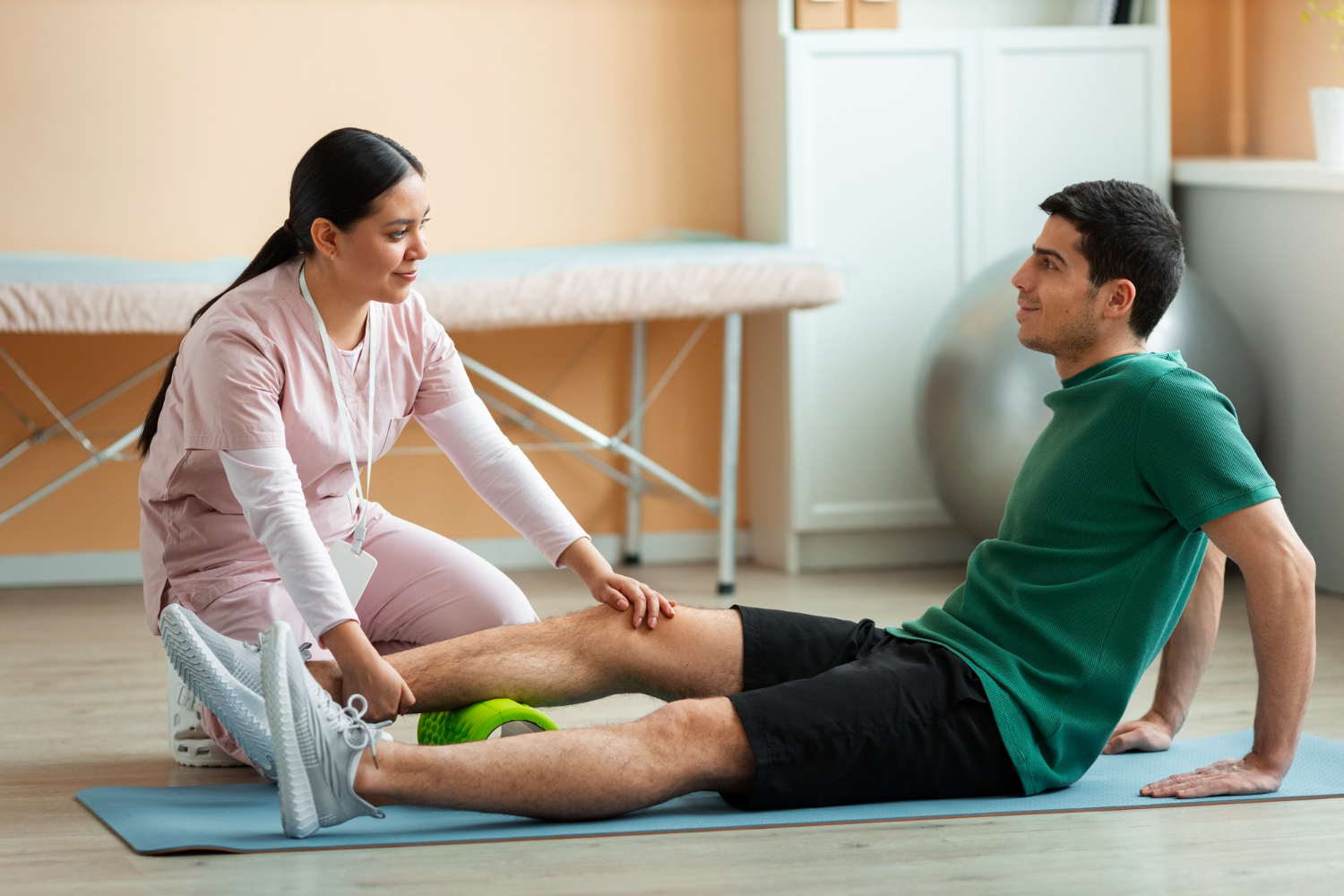Synopsis
Knee pain is among the most common musculoskeletal complaints across age groups. Whether caused by age-related degeneration, injury, or poor movement patterns, physiotherapy offers a scientifically proven path to recovery. This blog explores the benefits of structured physiotherapy for knee pain, explaining how targeted interventions reduce inflammation, rebuild joint strength, and improve mobility. Through physiotherapy exercise for knee pain, patients can enhance muscle support around the knee, thus relieving pressure on the joint. From beginners to post-surgical patients, personalised knee joint pain physiotherapy programs accelerate healing. We also cover the growing demand for physio for sore knee cases driven by sedentary lifestyles and fitness injuries. Learn how expert guidance, evidence-based therapy, and consistent monitoring from a certified knee physiotherapist can return you to daily function, sports, and pain-free living. Whether you’re searching for knee physio near me or just want to avoid surgery, this article provides a complete recovery roadmap for knee health.
Table of Contents
- Understanding Knee Pain: Common Causes
- How Physiotherapy Treats Knee Pain
- Knee Strengthening Exercises for Recovery
- The Role of a Knee Physiotherapist
- Benefits of Physiotherapy for Sore Knees
- Why Knee Physio Is Not Just for the Elderly
- Finding the Right Knee Physio Near You
- Why Orthocure Offers Trusted Knee Rehabilitation
Understanding Knee Pain: Common Causes
Knee pain can stem from multiple factors including ligament injuries, osteoarthritis, meniscus tears, overuse, or postural imbalances. Each cause demands a unique treatment path, but many respond well to physiotherapy for knee pain. The pain may feel localised or radiate down the leg depending on the underlying issue. Physiotherapists use assessment tools to identify dysfunctions in mobility, alignment, and muscular strength before prescribing treatment.
How Physiotherapy Treats Knee Pain
Knee joint pain physiotherapy is a conservative and highly effective approach to reduce swelling, restore joint mobility, and improve stability. Treatment may include soft tissue mobilisation, isometric exercises, cryotherapy, ultrasound, and manual therapy. Importantly, a structured plan addresses the root cause rather than simply treating symptoms. Progressive loading techniques also ensure that recovery strengthens the knee instead of overstraining it.
Knee Strengthening Exercises for Recovery
Rehabilitation relies heavily on the correct physiotherapy exercise for knee pain, as muscles surrounding the joint play a pivotal role in pain management. Strengthening the quadriceps, hamstrings, and calves supports the patella and stabilises movement. Controlled squats, heel slides, step-ups, and resistance band routines are prescribed based on the stage of recovery. These exercises are crucial to rebuild confidence in the knee and avoid further injury.
The Role of a Knee Physiotherapist
A knee physiotherapist does more than administer exercises—they provide ongoing assessment, postural correction, and biomechanics education. Their intervention often prevents unnecessary surgical intervention. They also educate patients on safe movement patterns, footwear recommendations, and daily activity modifications. Each plan is adjusted weekly to ensure continued progress and prevent relapse.
Benefits of Physiotherapy for Sore Knees
Physio for sore knee is ideal for conditions arising from temporary strain, fitness injuries, or prolonged standing. Rather than relying on painkillers or rest alone, therapy helps improve circulation, release muscular tension, and prevent chronic stiffness. Many professionals and athletes seek physiotherapy early to manage minor soreness before it escalates into serious joint problems.
Why Knee Physio Is Not Just for the Elderly
Contrary to common belief, physiotherapy for knee pain is not restricted to the elderly. Young adults with sports injuries, IT professionals with prolonged sedentary posture, and postpartum women can also benefit. Early intervention often prevents degeneration or recurring pain episodes. With an increase in running and fitness trends, more youth are seeking therapy for strain and instability issues.
Finding the Right Knee Physio Near You
Patients often search online for a knee physio near me, hoping for convenience and expertise. While proximity matters, the physiotherapist’s qualifications, technology available, and success stories are more important. Look for clinics offering assessment-based planning, guided exercises, and outcome tracking. At Orthocure, all knee programs are personalised and medically reviewed to ensure safe, sustainable healing.
Why Orthocure Offers Trusted Knee Rehabilitation
Orthocure Clinics & Gyms provide a robust ecosystem for physiotherapy for knee pain, offering a unique blend of diagnostics, targeted therapy, and medically guided rehabilitation. Each patient receives a customised plan based on their strength, range of motion, and pain thresholds. With MedX machines and evidence-based protocols, we ensure progress with each session. Whether you’re dealing with arthritis, ligament tears, or post-operative care, our knee physiotherapists are equipped to support complete recovery.
FAQs
What are the most effective physiotherapy exercises for knee pain?
Exercises like quadriceps sets, straight leg raises, mini squats, and step-ups help strengthen muscles around the knee. A physiotherapist customises the program based on the patient’s pain level and movement restriction. Regular progression in difficulty ensures optimal recovery. These exercises improve joint support and reduce pressure on the knee cartilage. Supervised therapy ensures safe execution and long-term results.
Can physiotherapy help avoid knee surgery?
Yes, many patients avoid surgery by committing to structured physiotherapy. By improving joint alignment, muscle strength, and mobility, physiotherapy can significantly reduce pain and inflammation. It also enhances function, helping patients return to regular activity. Early intervention provides better outcomes. It’s essential to consult a trained knee physiotherapist to evaluate the condition.
How long does knee physiotherapy take to show results?
Most patients begin to feel relief within 2–3 weeks of consistent therapy. Full recovery depends on the condition’s severity and patient adherence. Chronic conditions may require 6–8 weeks of treatment. Gradual progression ensures joint protection and muscle endurance. A therapist will track progress and adapt exercises as needed.
What is the role of a knee physiotherapist in treating joint pain?
A knee physiotherapist assesses the biomechanical and muscular structure around the knee to identify dysfunctions. They provide hands-on treatment, customised exercises, and education on movement correction. Their expertise ensures that the therapy is safe, progressive, and effective. They also monitor healing and modify plans accordingly. Their involvement is crucial for long-term pain relief and mobility.
Is knee physiotherapy beneficial after surgery?
Absolutely. Post-surgical physiotherapy restores range of motion, prevents scar tissue build-up, and strengthens muscles to protect the joint. It also reduces swelling and improves balance. Delaying therapy after surgery may lead to stiffness and weak support structures. A well-structured plan ensures complete recovery and confidence in daily movements.





